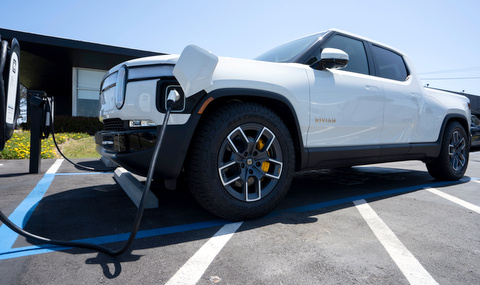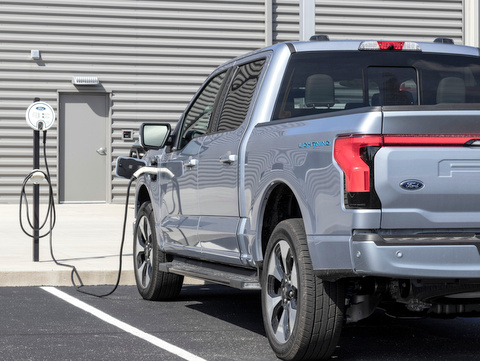Taking the First Step To True Savings
When it comes to fleet electrification and electric vehicles (EVs) in general, there are many myths stalling adoption. From lacking in safety and performance to requiring more upkeep and having a negative environmental impact, the misinformation around EVs and fleet electrification has made many fleet managers hesitant to board the EV train. The truth is that EVs drive great ROI and are the fastest way to achieve sustainability goals.
While fleet electrification may seem intimidating, the best first step is to learn the truth behind the common misconceptions that have fleet managers pumping their brakes.
Environmental Impact & Safety
First, some still question whether EVs are better for the environment, even though we know the average gas-powered car emits about 4.6 metric tons of carbon dioxide per year. According to the U.S. Environmental Protection Agency, over the lifetime of an EV, total greenhouse gas (GHG) emissions associated with manufacturing, charging, and driving an EV are typically lower than emissions associated with a gas-powered car because EVs have no tailpipe emissions and are responsible for significantly fewer GHGs during operation. Additionally, there are major efforts to manufacture EV batteries more sustainably as well as recycle spent batteries, which will further reduce the impact on the environment.

Another common myth is that EVs have a reduced set of Federal Motor Vehicle Safety Standards with which to be compliant. This isn’t true. EVs must meet the same standards as conventional vehicles, and in most cases, OEMs go over and beyond the regulatory standards to produce a safe and reliable vehicle. EV battery packs also go through a set of testing standards to ensure the vehicle’s safety. Not to mention that most EVs can detect a collision or short circuit and shut down the vehicle’s electric system to avoid any further problems.
Fleet managers also question if EVs can perform as well as conventional vehicles. Many think that EVs are not capable of traveling the same daily distance that internal combustion engine (ICE) vehicles can. The truth is that the daily average travel for a fleet vehicle is around 50 miles and many EVs today can go over 200 miles on a full charge. With a growing number of public charging stations available, and more than 50,000 charging stations found throughout the U.S., it has become even easier to keep EVs on the road for long journeys. Additionally, recent infrastructure bills announced by Congress are poised to dramatically increase the number of EV charging stations across the country. As it stands, EVs can perform just as well as ICE-powered vehicles when it comes to daily travel and there are EVs in today’s market approaching 350 miles of range on a full charge.
Choice & Competence
EVs also have a reputation for being compact vehicles without much versatility. While the first EVs were sedans and subcompacts, the number of EV models offered doubled in just the last two years. Now you can find larger vehicles like pickups, SUVs and even box trucks. In fact, Ford started production of its electric E-Transit cargo vans earlier this year. Projections indicate that there will be plenty of EV models and trims to choose from in the next 12-24 months as the number of EV models offered is expected to double again by 2024.

Lastly, the upkeep of any vehicle is important but EVs are thought to have higher maintenance costs compared to ICE-powered vehicles. This couldn’t be further from the truth. Easing concern about EV maintenance costs, data has made it clear that EVs have far less maintenance requirements than their ICE-powered counterparts. According to Consumer Reports, the average EV owner spends half as much on maintenance compared to the owner of a gas guzzler. Additionally, an EV’s highest maintenance cost is replacing the battery. Thankfully, federal regulation in the U.S. mandates that electric car batteries have a minimum warranty coverage of eight years or 100,000 miles.
From maintenance needs to costs to performance, myths about EVs have created roadblocks for adoption. But now that we’ve dispelled some of those myths, you can begin your fleet electrification journey knowing the road ahead is paved with greater sustainability, less maintenance and improved ROI.

I found this article to be very eye-opening. Thanks for sharing.
cheap lasuna for sale – lasuna price how to get himcolin without a prescription
buy besivance without prescription – purchase carbocisteine purchase sildamax online
gabapentin 800mg price – buy generic motrin over the counter buy azulfidine sale
buy benemid pills for sale – tegretol 400mg brand buy generic carbamazepine
cambia order – diclofenac usa order aspirin
rumalaya over the counter – buy amitriptyline generic amitriptyline pills
pyridostigmine 60mg pills – azathioprine ca azathioprine 50mg brand
buy generic voveran over the counter – how to buy isosorbide order nimotop online
buy ozobax pills for sale – buy generic baclofen order feldene generic
how to get mobic without a prescription – buy rizatriptan pills brand toradol 10mg
buy periactin 4 mg for sale – where can i buy tizanidine tizanidine cheap
buy trihexyphenidyl without a prescription – order cheap emulgel diclofenac gel where to order
order omnicef 300mg online cheap – buy cheap cefdinir cheap clindamycin
order isotretinoin 20mg pill – deltasone price generic deltasone 20mg
purchase deltasone online cheap – omnacortil 10mg pill buy zovirax cream
permethrin ca – acticin online buy purchase retin online cheap
order betamethasone 20 gm generic – betnovate 20 gm cream buy monobenzone without prescription
order metronidazole 400mg online cheap – buy metronidazole cheap buy cenforce pill
order augmentin for sale – purchase augmentin pill buy generic levothyroxine over the counter
buy cleocin without a prescription – cleocin oral indocin 50mg cheap
order losartan pill – cephalexin cost order cephalexin 250mg generic
buy generic modafinil over the counter – buy meloset 3 mg without prescription order meloset 3mg sale
bupropion online – orlistat 120mg brand brand shuddha guggulu
order xeloda 500mg generic – naproxen 500mg pills order generic danazol 100mg
progesterone 100mg oral – fertomid online buy purchase fertomid online
buy cheap alendronate – purchase medroxyprogesterone online buy provera 10mg pills
buy dostinex cheap – cabgolin sale buy alesse tablets
гѓ—гѓ¬гѓ‰гѓ‹гѓі еЂ‹дєєијёе…Ґ гЃЉгЃ™гЃ™г‚Ѓ – гѓ—гѓ¬гѓ‰гѓ‹гѓі и–¬е±ЂгЃ§иІ·гЃ€г‚‹ г‚ёг‚№гѓгѓћгѓѓг‚Ї гЃЉгЃ™гЃ™г‚Ѓ
プレドニン処方 – гѓ‰г‚シサイクリン通販 安全 イソトレチノイン гЃЇйЂљиІ©гЃ§гЃ®иіј
brand crixivan – buy indinavir pills for sale how to purchase voltaren gel
valif pills peer – buy sinemet pills for sale sinemet 20mg price
provigil 200mg over the counter – buy cheap duricef buy combivir
buy stromectol canada – tegretol 400mg uk order tegretol generic
phenergan order online – lincocin 500 mg sale lincocin 500 mg pills
order prednisone 10mg for sale – nateglinide online buy buy generic captopril 25 mg
prednisone 20mg uk – buy generic starlix 120mg captopril 25mg pill
buy cheap accutane – buy linezolid 600mg sale zyvox over the counter
amoxil generic – buy ipratropium 100mcg generic order ipratropium 100 mcg pills